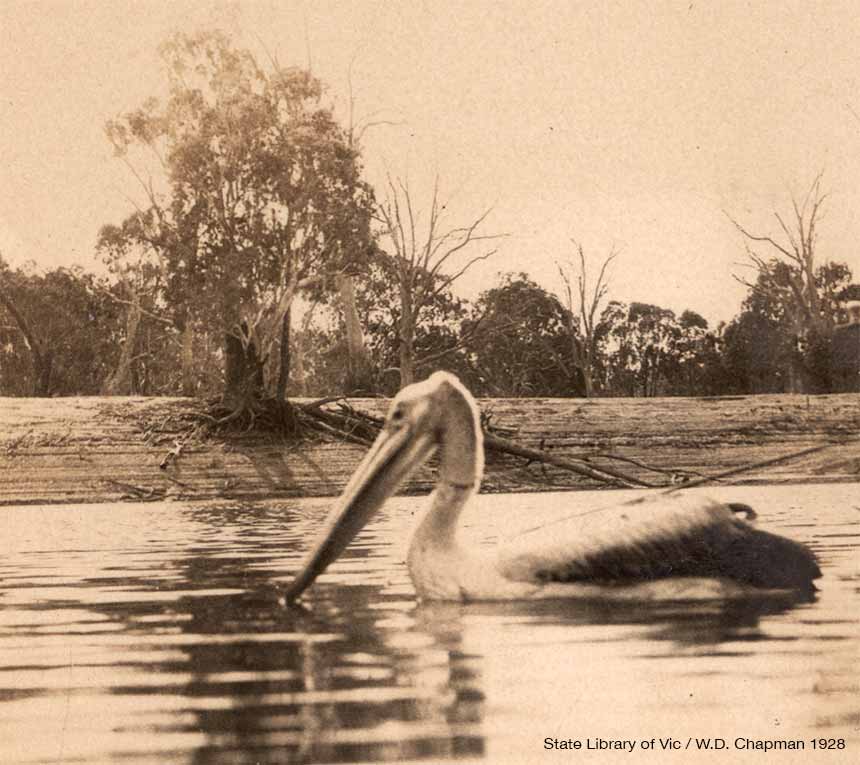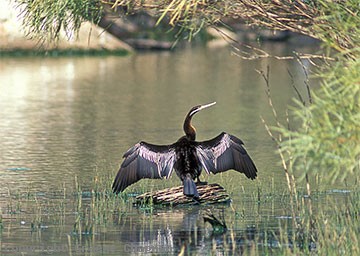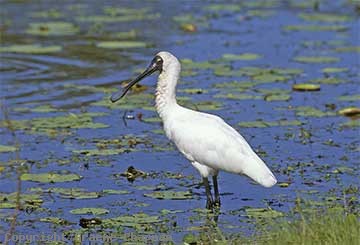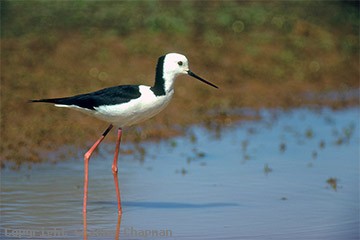

and other waterbirds
This vantage point at Pelican Lookout provides a wonderful opportunity to sit for a while and look out for waterbird activity along this stretch of the Warrego River. Included below are some of the birds to watch out for in addition to their calls which you may well hear before you see them.


Pelican
Pelecanus conspicillatus
Pelicans are highly mobile, searching out suitable areas of water and an adequate supply of food. Pelicans are not capable of sustained flapping flight, but can remain in the air for 24 hours, covering hundreds of kilometres. They are excellent soarers and can use thermals to rise to considerable altitudes. Flight at 1,000m is common, and heights of 3 000 m have been recorded. By moving from one thermal to the next, pelicans can travel long distances with a minimum of effort, reaching air speeds of up to 56 km/hour. The bill and pouch of pelicans play an important role in feeding. The bill is sensitive and this helps locate fish in murky water. It also has a hook at the end of the upper mandible, probably for gripping slippery food items. When food is caught, the pelican manipulates it in its bill until the prey typically has its head pointing down the pelican's throat. Then with a jerk of the head the pelican swallows the prey. The bill is delicately built. The lower jaw consists of two thin and weakly articulated bones from which the pouch hangs. When fully extended, the bill can hold up to 13 litres. The pouch does not function as a place to hold food for any length of time. Instead it serves as a short-term collecting organ. Pelicans plunge their bills into the water, using their pouches as nets. Once something is caught, a pelican draws its pouch to its breast. This empties the water and allows the bird to manoeuvre the prey into a swallowing position. The pouch can also serve as a net to catch food thrown by humans, and there are sightings of pelicans drinking by opening their bill to collect rainwater.
Photo: Graeme Chapman Text: Birds in Backyards Audio: macaulaylibrary.org (Sara Young)


Darter
Anhinga novaehollandiae
Darters feed largely by swimming underwater to pursue small fish, insects and other aquatic prey. Occasionally they use their dagger-like bill to spear larger fish or even small tortoises and then they have to surface in order to shake them free and swallow them whole. They also swim on the surface with just the head and some neck protruding in which case they are quite inconspicuous.
Like cormorants, the plumage of Darters is not waterproof, so they spend a lot of time perched out in the sun to dry out their feathers. They fly straight and strong with the neck tucked in so it isn't at all obvious that they are a Darter and not some other bird. They build a stick nest in a tree, often overhanging water and usually solitary, just occasionally in a small well-spaced colony. Their loud repeated cackling call is one of the outstanding sounds of the wetlands.
Photo, audio, text:Graeme Chapman


Little Pied Cormorant
Microcarbo melanoleucos
Wandering around Australia you are more likely to come across a Little Pied Cormorant before you see any of the other types of cormorants. They seem to be everywhere, just the odd bird or two even on the smallest farm dam out in the back of beyond. There is a reason for this, it's where they find yabbies, one of their favourite foods. When nesting, they do assume a breeding plumage which is fairly subtle - the bill becomes more orange and there is a short black crest on the forehead. They build a stick nest in a tree or shrub, often in colonies.
Photo,text: Graeme Chapman Audio: macaulaylibrary.org (Sara Young)


White-faced Heron
Egretta novaehollandiae
White-faced Herons are probably one of the most familiar large wading birds to everyday Australians - known colloquially as "Blue Crane", their range is Australasian - Australia, Tasmania, New Zealand, parts of New Guinea and many outlying islands but absent from our waterless deserts. White-faced Herons forage mainly in and around the edges of shallow water, both salt and fresh but they also feed on land. We often see them in our back garden where they catch small skinks. They are usually solitary when feeding although occasional scattered flocks of up to 60 or so have been seen on inland swamps, especially when they are drying up and food is more concentrated. When concentrating on prey they can be rather comical to watch - peering forward with head quite still but the neck swaying to and fro. They build a substantial stick nest usually high up in a tree, but in treeless areas such as swamps, in a variety of shrubs and bushes close to the water. Their movements are driven by climate and weather - in coastal areas where water levels are stable they are resident but further inland they move around in response to available water.
Photo,text: Graeme Chapman Audio: macaulaylibrary.org (William Ward)


Royal Spoonbill
Platalea regia
The Royal Spoonbill feeds mainly on fish in freshwater, and on shrimps in tidal flats; it will also eat other crustaceans and aquatic insects. The structure of its bill limits it to feeding in water that is less than 40 cm deep over sand, mud or clay, where it can sweep the water with its bill. It uses several methods to catch food: slow sweeping from side to side with an open bill, rapid sweeping while walking fast or even running through the water, as well as dragging, probing or grabbing. The spatulate bill has many vibration detectors, called papillae, on the inside of the spoon, which means the bird can feel for prey items even in murky water and can feed by day or night. Once food is caught, it lifts its bill up and lets the items slide down its throat. It will bash shrimps against hard objects to remove their shells.
Photo: Graeme Chapman Text: Australian Museum Audio: macaulaylibrary.org (David Fleming)


Black-winged Stilt
Himantopus himantopus
The long, slender bill of the Black-winged Stilt is used like a pair of fine tweezers as the bird forages by pecking at tiny invertebrates on the water’s surface. Although this is its most common feeding method, stilts have been recorded using at least nine different methods to feed. They usually forage by wading in water up to belly deep, but also feed along the muddy margins of wetlands, regularly forming large, noisy feeding flocks, often in association with Banded Stilts and Red-necked Avocets.
Photo, audio: Graeme Chapman Text: birdlife.org.au


Black Swan
Cygnus atratus
The black swan is common in the wetlands of southwestern and eastern Australia and adjacent coastal islands. It's preferred habitat extends across fresh, brackish and salt water lakes, swamps and rivers with underwater and emergent vegetation for food and nesting materials. It also favors permanent wetlands, including ornamental lakes, but can also be found in flooded pastures and tidal mudflats, and occasionally on the open sea near islands or the shore. The black swan was once thought to be sedentary, but is now known to be highly nomadic. There is no set migratory pattern, but rather opportunistic responses to either rainfall or drought. In high rainfall years, emigration occurs from the south west and south east into the interior, with a reverse migration to these heartlands in drier years. The black swan is almost exclusively herbivorous, and while there is some regional and seasonal variation, the diet is generally dominated by aquatic and marshland plants.
Photo: Graeme Chapman Text: Wikipedia. Audio: macaulaylibrary.org (Andrew Spencer)


Eastern Great Egret
Ardea modesta
One of Australia’s most elegant birds, the snowy-white Eastern Great Egret is often seen wading in a range of wetlands, from lakes, rivers and swamps to estuaries, saltmarsh and intertidal mudflats. They usually feed in shallow water, standing and waiting for fish, frogs, insects and other small aquatic creatures to appear before stabbing them with its long, yellow bill. They also walk slowly through the water, on the lookout for prey. Large fish are eaten with difficulty, and are often snatched from the bill of the egret by raptors.
Photo, audio: Graeme Chapman Text: Birdlife Australia


Black-fronted Dotterel
Elseyornis melanops
Widespread throughout Australia Tasmania and in recent times New Zealand, Black-fronted Dotterels are a familiar sight around the edges of the smallest, even ephemeral wetlands where they feed both in shallow water or along moist edges. When temporary wetlands dry out they become nomadic but in the more permanent places such as rivers and swamps, adults occur as pairs and when breeding form small territories.
Photo, text: Graeme Chapman Audio: macaulaylibrary.org (David Fleming)

7. Kangaroos / emus
9. Meatants
